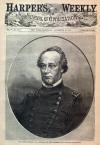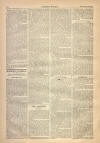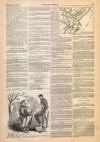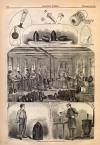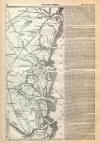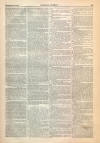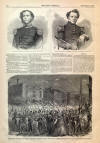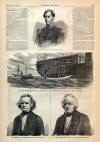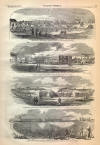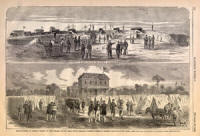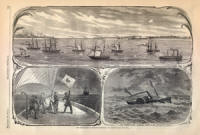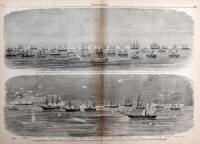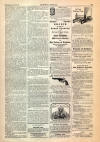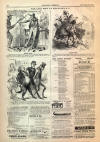Map of South Carolina Coast
|
|
This Site:
|
HARPER'S WEEKLY. [NOVEMBER 30, 1861. 762 MAP OF THE SEA-COAST OF SOUTH CAROLINA, SHOWING THE DEPTH OF WATER ON EACH BAR, ETC.THE CAPTURE OF BEAUFORT, SOUTH CAROLINA.WE devote a large proportion of our space this week to illustrations of the glorious achievements of the GREAT EXPEDITION. On page 764 we give portraits of BRIGADIER-GENERAL SHERMAN, who commanded the troops, and of CAPTAIN DUPONT, who commanded the fleet ; on pages 760 and 761 a view of THE FLEET as it appeared in the ocean on Thursday 31st ; on page 757 a picture of THE RECONNOISSANCE which was made on the day previous to the attack on the forts; on the same page, illustrations of the METHOD OF SIGNALING adopted in the fleet, and of the "WINFIELD SCOTT" in the gale ; on pages 760 and 761 a large view of the BOMBARDMENT OF FORTS WALKER AND BEAUREGARD; on page 756 a couple of pictures showing the general appearance of FORT WALKER, and the building occupied originally by General Drayton as his head-quarters, and subsequently by General Wright ; and on this page A MAP SHOWING THE COAST OF SOUTH CAROLINA AND THE APPROACHES TO BEAUFORT, with the depth of water, in figures, on each bar. Of the appearance of the fleet on 31st October the correspondent of the Herald writes: The wind died out before sunrise, and the sea was as smooth as a millpond, only a gentle swell disturbing its bosom. At noon our position, by observation, was as follows: Latitude 34 degrees 37 minutes north, longitude 75 degrees 50 minutes west. Distance made sixty-eight miles, making a southwest three-quarter south coast; so that we are now about thirty miles off shore, and not yet in the latitude of Cape Lookout. The barometer is 30 degrees 3 minutes, and the thermometer at 70 degrees. Not a cloud has been seen to-day, and we have been enjoying the scene very much. The sick are much better, and those who lost their peace of mind yesterday have found it to-day, and not one vacant place was to be seen at the dinner-table. The soldiers have been exercised in rifle firing this afternoon, and have acquitted themselves finely. Most of the vessels had canvas set this morning, but as it fell away dead calm this afternoon all sails were furled, and the yards braced sharp up. The RECONNOISSANCE is thus described by the same writer: At five on 5th we got under way and went alongside of the flag-ship for our orders. At daylight we were ordered to take on board Brigadier Generals Sherman, Wright, and Stevens, with their staffs, and to proceed under their direction to make a thorough reconnoissance of the batteries at Hilton Head and Bay Point. We lay astern of the flag-ship until the Generals were brought to us in one of the Atlantic's boats. Then we started upon our trip. The weather was beautiful, and all were in the best of spirits. We ran along as fast as possible, so as to join the firing at its earliest stages, so that we can make a careful note of positive strength, etc. On we steamed, expecting every moment the rebels would open fire on our ships; but they evidently were waiting until they should get into ranges which they had for their guns. At twenty minutes before seven o'clock the first gun was fired from the rebel flag-ship (the Everglade), and in less than one minute afterward the Lady Davis let slip a shot at the ships. In five minutes the firing became quite lively on both sides, the gun-boat Ottawa opening the fire on our side. The following boats took part in the skirmish: The Ottawa, with Flag-captain Rodgers on board; Pembina, Seneca, Curlew, Penguin, and Isaac Smith, the Pawnee coming in after the firing had well advanced. As we drew up toward the batteries the one on Hilton Head opened upon us—this being the first time we had any positive knowledge of there being any guns at that place. As we drew within range of the Bay Point battery it also opened upon us. After about twenty rounds we found the Hilton Head battery to contain sixteen guns, while the Bay Point battery had only thirteen; but just below that battery was one which was not yet completed. The gun-carriages were there, but no guns were to he seen; men were seen working there yesterday, but to-day they have gone down to fight in the main battery. After the boats had run away they sought shelter behind the point, while our boats threw in shell toward the batteries at intervals. As we were only on a reconnoissance it was not necessary for us to attempt to rout the rebels—so the recall signal was hoisted, and we prepared to anchor. Just as we were hauling off the Pawnee got into position and opened fire upon the Hilton Head battery; most of her shot fell short, but a rifled sixty-eight pounder threw in shell beautifully. The rebels threw the shot around her very fast, but all fell short. As soon as we started to go back the rebel navy came down and followed us afar off. The Curlew fired a few rounds at the battery, and then hauled off; and the little Mercury ran in, showed them her stern. and let drive a shell at them front her thirty-pounder, it bursting close into the rebel camp. Thus ended the first regular army reconnoissance, in which the navy did all the work and the army did one half of the looking on. The BOMBARDMENT itself is thus described : Just as we had anchored, which was at five minutes before ten o'clock, the Hilton Head battery opened fire on the Wabash; in three minutes after another shot from the battery. Now the cheers arose from all the transports; the ball had opened. Still the ships stood on and did not apparently notice the efforts of the rebels, until the Wabash came in good range with the face of the battery, when she fired a shell at them which struck close to the battery. In a few minutes the Wabash opened a smart fire, throwing her shells into the woods, where the rebels were encamped in some force. After firing a few guns to ascertain the range, she opened a broadside fire on both batteries, which was one of the finest sights ever witnessed in this country. Now the troops did cheer. It was hearty and long. The other vessels now opened their fire, and the shells fell thick and fast into the battery. The rebel steamers now opened a smart fire, and it was the subject of general remark at the fine shots they made. The small gun-boats now steamed rapidly ahead, and opened on them with their ten and eleven inch pivot guns. At fifteen minutes past ten o'clock the fire was so hot that they up helm and started for Broad River, the gun-boats chasing them. By this time the shells were bursting in the Bay Point battery at the rate of about two a minute, to which the rebels replied with rapidity and great execution. The flag-ship and her division were rapidly drawing up to the point around which they were to turn so that they could come down along the shore and engage the Hilton Head battery, while the small gun-boats took up independent positions, and battered away at Bay Point and the rebel naval vessels. As the Wabash turned, so that her broadside could bear upon the rebel fleet, she opened upon them, and soon sent them up the river for a time at least. About this time the Vandalia came up in range, and she delivered a splendid broadside to the Bay Point rebels, several of her shells making the sand fly inside of the works. She kept up a galling fire upon them until out of reach, when she devoted her attention to the rebel navy During this time this Wabash, Susquehanna, and Bienville had come around, and were close upon the Hilton Head battery. All eyes were upon these vessels, especially as we saw plainly that they were steering so as to come within six hundred yards of the rebels gulls, some of which we knew were excellent rifled pieces of the most approved patterns. We expected great doings, and I will guarantee that we were not disappointed, as the sequel will show. On they came, a little world in themselves, but the flag-ship seemed to be the one on which all placed their hopes for a grand sight. At about twenty minutes before eleven o'clock the Wabash commenced operations on the Hilton Head battery in good earnest, delivering a broadside at one command. All her gun-deck armament is nine-inch shell guns, while on her spar-deck they are eight-inch shell gulls, with a ten-inch pivot aft and a sixty-eight rifled Dahlgren gun on the forecastle. If you can imagine the scene you can do more than I can describe. The noise was terrific, while the bursting of the shells was as terrible as it was destructive. I counted no less than forty shells bursting at one time, and that right in the battery and in the woods where about eight hundred rebels lay. In addition to this the Susquehanna, with her tremendous battery, aided by the Bienville, the Pawnee, and half a dozen smaller gun-boats, was making the air brown with the sand, while the blue smoke of the explosion went to make up a most magnificent sight. The troops were wild with enthusiasm, and with deafening cheers they applauded the boldness and courage of the gallant naval officer. A moment or two elapsed—just time enough to load the guns—and again the scene was enacted afresh. The rebels replied with seven guns, which were worked splendidly, and from appearances they did considerable execution. After the second broadside the firing became less concerted, and it seemed as if each division on all the vessels were endeavoring to outvie each other in the rapidity with which they worked their guns. The tide drifted the vessels quite fast by the battery, but they backed them considerably, so as to remain as long as possible ; and at eleven o'clock they had reached as near to the reef as it was safe to go, and they were obliged to haul off to again take up their position, but giving them another broadside as they turned. To do this a track, circular in form, and extending nearly five miles, must be sailed over. The Bay Point battery must again be passed, where there were several fine rifled cannon, which were well served; and the navy of the Confederates must receive their due share of the shells which were destined to be expended on this day's work. To this duty they undauntedly steamed up, while the little gun-boats fought the steamers. About this time the firing on both sides materially diminished. Occasionally the rebels fired from either battery, which was replied to by the gun-boats. At half past eleven the Wabash and her consorts drew near to the Hilton Head battery again, the rebels keeping up a brisk fire upon them as they approached. Occasionally the pivot guns of the Wabash and the Susquehanna threw a shell into the battery: but the grand affair was yet to come. At ten minutes before twelve o'clock again the ships were enveloped in a dense cloud of white smoke, and in a few seconds after the shells were bursting into the battery in a splendid manner. The sand was flying in every direction, and it seemed impossible that any one could be saved from death who was within the walls of the battery. Such a sight was never witnessed before. The rebels now worked only two guns, but I will give them the credit of working them beautifully. This style of fighting lasted just twenty minutes, and in that time over two hundred shells had burst, over their heads and in the works. At ten minutes past twelve again the ships hauled off, firing a parting round as they left. Bay Point battery ceased firing about noun, and hauled down the barred rag. At twenty minutes past twelve the Bay Point battery opened fire on the Wabash as she passed up to take her position. Five minutes afterward the gun-boats opened a terrible volley of shells on Hilton Head, breaching it in several places, and dismounting one of the guns. This display of gunnery was a grand sight, and was only second to the broadside firing of the other ships. The gun-boats kept up this kind of work several minutes, when they eased down and tired at intervals, so that (Next Page) 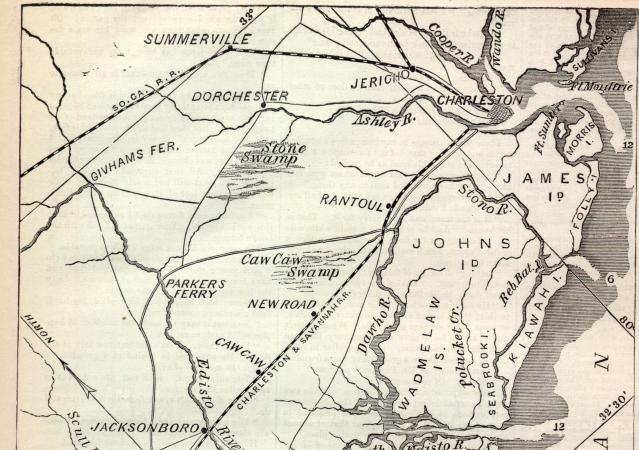 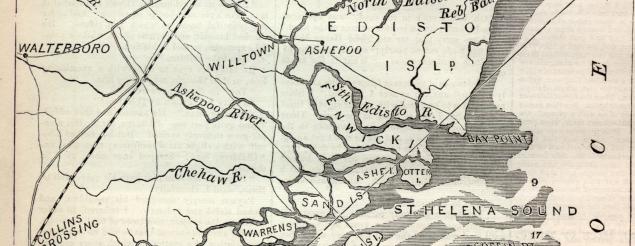 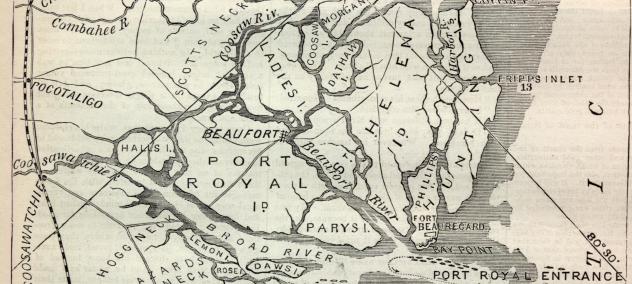 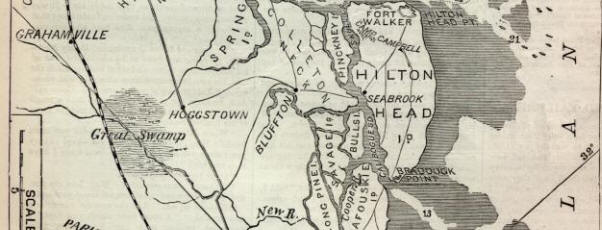  |
||||||||||||||||||||||||||
|
|
||
|
|
Site Copyright 2003-2018 Son of the South. For Questions or comments about this collection, contact: paul@sonofthesouth.net |
|
|
Are you Scared and Confused? Read My Snake Story, a story of hope and encouragement, to help you face your fears. |
||
